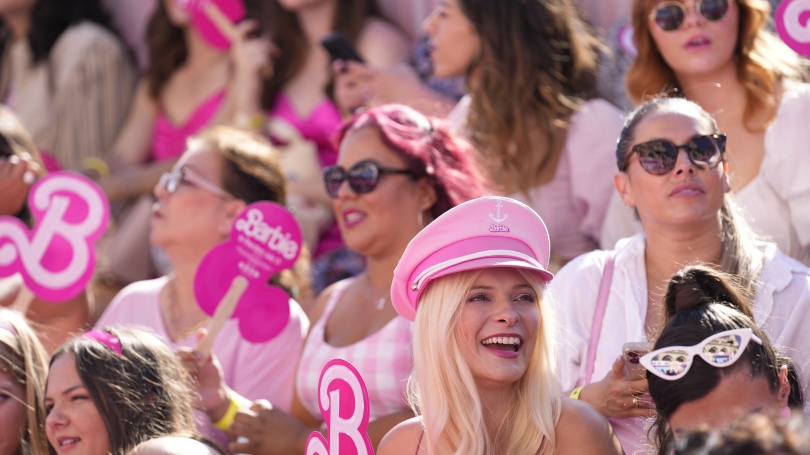

Film scholar Mary Desjardins and digital humanist Roopika Risam break down the pop culture phenomenon inspired by the hit movie.
As Barbie races toward the $1 billion mark at the global box office—surpassing recent blockbusters Indiana Jones 5 and Mission: Impossible 7—the film continues to inspire filmgoers the world over to flaunt pink and bond over their shared love for the decades-old Mattel doll.
Backlash against Barbie's unrealistic and overly sexualized body in years past makes the pop culture phenomenon all the more surprising.

Here, film scholar Mary Desjardins and digital humanist Roopika Risam break down the Barbie hype. A professor in the Department of Film and Media Studies, Desjardins studies media history, film and television stardom, feminist theory, gender and the media, feminist filmmaking, and print culture and history.
Risam is an associate professor of film and media studies and of comparative literature and part of Dartmouth's Digital Humanities and Social Engagement Cluster. Her research straddles postcolonial and African diaspora studies, humanities knowledge infrastructures, and the digital humanities.
Mary Desjardins: Barbie personifies the contradictions of femininity in patriarchal society.
The Barbie doll was born out of contradiction—inventor Ruth Handler based her on a sexy pin-up character popular in German media, but she wanted girls to have a doll that offered play opportunities beyond modeling motherhood. Over the years Barbie's unrealistic and overly sexualized bodily dimensions have been subject to critique, not only from feminists, but also in Todd Hayne's controversial, experimental video biography of anorexic singer Karen Carpenter enacted by Barbie dolls and cheaper knock-offs.
The sophistication of Greta Gerwig's Barbie is that the character retains this history of promise and critique, of feminist impulse compromised by patriarchal expectations and consumer capitalism. Why the film has struck a nerve is that it takes the familiar fairy tale of a toy's journey to "personhood" (think Pinnochio and The Velveteen Rabbit) and reveals in her very funny picaresque adventures that Barbie's "realness" comes from the imagination and experiences of girls who have loved her, of girls who have rejected and defaced her, of those girls who grew up to be women (some of them feminists) living the contradictions of femininity in patriarchal society.
I saw it in a predominantly working-class town in the Upper Valley, with an audience of mainly middle-aged mothers with their little girls. These women laughed at the film's jokes about Ken's cluelessness, its parodies of masculinity, and clapped after America Ferrara's feminist monologue about unrealistic expectations for women. In my almost 40-year career as a film scholar, I have never been in a screening of a mainstream film with that kind of enthusiasm from a female audience.
I think a large proportion of the adult female audience, whether they had a Barbie or not as a child, whether or not they hate the doll and all she represents of consumer culture and gender stereotypes, feel the film represents something of their experience, and this is apparently very threatening to some of the men who have denounced it.
Roopika Risam: Barbie is a triumph of social media-driven film publicity.
Barbie is, if nothing else, a triumph of social media-driven film publicity. It began with the trailer, which teased the barest hint of a multiverse plot and gave away little else, leaving would-be viewers drawing on nostalgia and the pop culture phenomenon that is "Barbie" to fill in the blanks. Unsurprisingly, the trailer went viral on social media platforms, where potential plot lines were hotly debated.
But the pièce de résistance was the Barbie Selfie Generator, which allowed users to create a version of one of the movie's posters with their own faces in it. Amused users shared the results on social media platforms, generating publicity and interest. Of course, internet audiences began uploading all kinds of images (I saw Danny Devito in a blond wig, horror movie doll M3gan, and even my best friend's horse), amplifying the popularity of this meme—and, in turn, the film.
Breaking Warner Bros.' box office records, the Barbie team's efforts to leverage social media clearly worked. But they also had another, unanticipated benefit. Because SAG-AFTRA is on strike, actors can't participate in publicity for the film—but they don't even need it because it's generating more than enough of its own through social media alone!